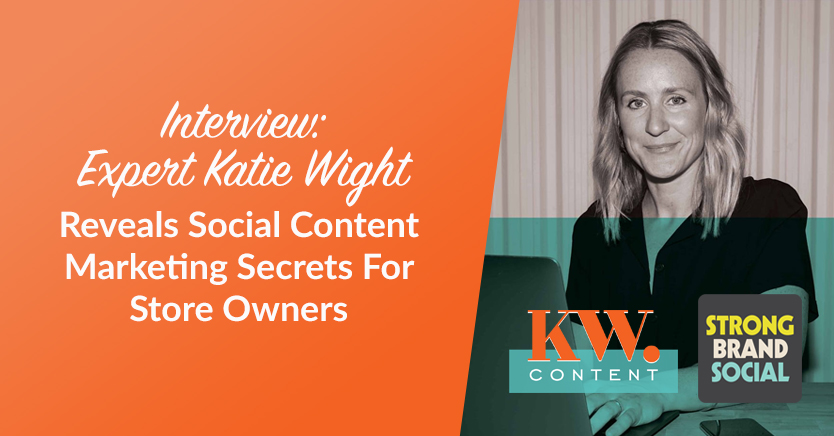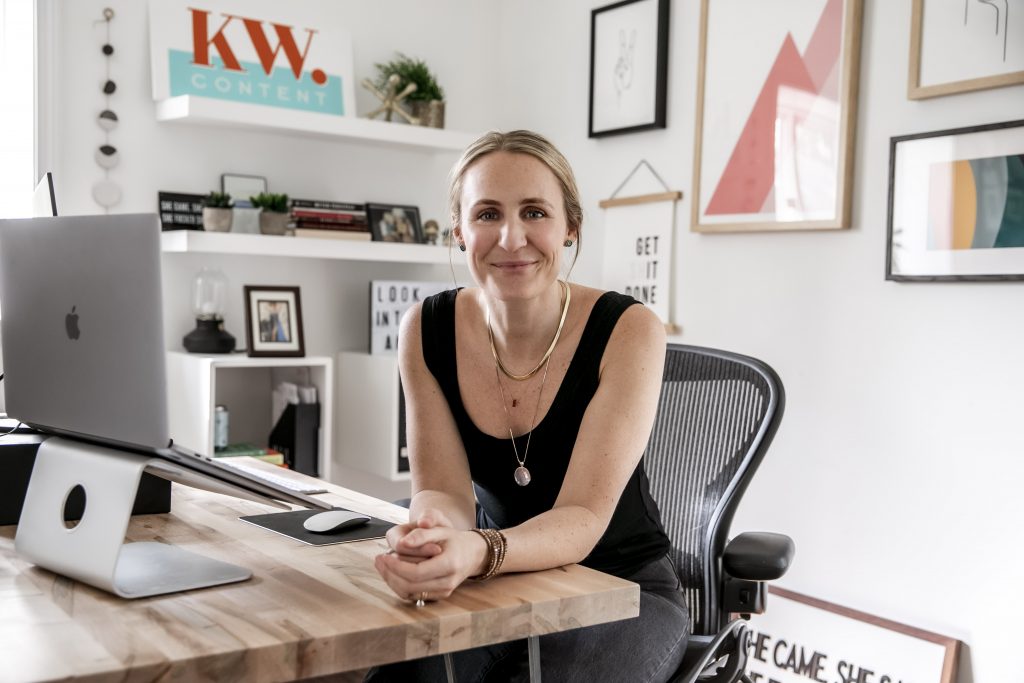
Hey store owners! Welcome to Wholesale Sellers Week and today we have a really special interview about social media content lined up for you.
I suggest you grab a coffee and a biscuit and settle in because this is amazing content strategy knowledge that you’d typically pay thousands for.
Katie Wight runs a social media content agency AND an online course teaching store owners this exact stuff.
She has graciously agreed to reveal some of her secrets here on the Wholesale Suite blog especially for our Wholesale Sellers Week.
So let’s jump right in!
Tell us a bit about yourself and your company and what you do for people.
My name is Katie Wight, I am the founder and owner of a social media marketing company that is one part agency done for you. This part of the agency is called KW Content. Here we provide, content strategy, content planning, content production, social media management and social media advertising, and community management services to our clients who are better for the world brands and leaders in their industry. Typically, one part of their business is eCommerce and one part is retail. Whether that’s wholesale or their own retail stores.
That scope of services is also what we teach on the other side of our business which is called Strong Brand Social, It is an online learning environment where we teach, we empower small brand owners to basically build their own high-performance content and social media marketing program from the inside out.

We provide these services in the agency but I feel strongly that these functions should be carried out internally from an internal team. The closer that your content creators and social media managers and brand marketers are to your brand the more authentic, the more unique, and therefore the more effective your content and social media will be for growing your business and connecting with your customers.
We launched that in April 2020 and we have over 10,000 students in there now. Mostly small brand owners and some up-and-coming social media managers. We have a membership community and all that good stuff.
For a store owner just coming into the world of using content to market their business, what kind of content would you say they should worry about first?
There are 3 content pillars or categories of content that folks should focus on. These are as follows:
1. Content that bridges the gap between your customers and you
The first is content that bridges the gap between your customers and you. This is what our market calls value-based content. It could be educational, it could be humorous. If you are selling food products like spices or any sort of ingredients or whole foods online an example of this would be recipe content. These are things that people search for and people can find value in.
Even if they don’t buy from you but it bridges the gap between you and them and establishes mutual interest and common ground. This is the content that grows your brand. These are what people come back for. This is what people share with their friends and it’s the content that builds trust between you and your target market.
2. Content that is all about your product
The second kind of content is all about the product that you are selling through your eCommerce store. This content needs to really spotlight your products. If you have a ton of products, it’s gonna be really focused on your bestsellers or your seasonal products, or anything you want to build your campaign around.
It should always be using customer-benefit-driven terms to describe your product. We want to be using layman’s terms. Not super techno-babble or anything like that.
3. Know, Like and Trust content
The third type of content is where I put all the know, like and trust content. I disagree that know, like and trust is a really strong model for content and social media marketing. I think that your know, like and trust content should actually just make up 20% of your total social media content.
That can be anything about you, it can be founder content, it can be supply-chain content, it can be values content or mission content. Anything that helps your customer get to know you better and understand if they want to have a long-lasting relationship with you.
…these 3 pillars, you’ll realize that they really mirror the way that we make relationships or friendships. The psychology behind building trust.
When you take a step back and look at these 3 pillars, you’ll realize that they really mirror the way that we make relationships or friendships. The psychology behind building trust. We find some common ground. It could be when you first meet someone and you realize you both have kids. That’s the universal common ground for people with kids. They always talk about how their kids are doing and they relate to that.
It could be that you have a mutual interest like sports or something in common and you start the conversation there. Then slowly the conversation comes back towards you two as individuals you get to know each other more. That is the purpose of those 3 pillars and those are the only 3 types of content that any new store owner should worry about.
What is something that you see a lot of store owners doing but won’t really get results?
The know, like and trust model on social media where we think that we just need to talk about ourselves until we have nothing left to say so that people can get to know us. The fact is that in order to build trust with you, your customers don’t actually need to know that much about you. They just need to know how well you know them. You need to center them in your story, find that common ground and mutual interest and that will build trust.
So know, like and trust is really fruitless. It’s just the type of content that people get really low engagement on. People are doing it all the time. I also see a ton of templated posts – Canva template, Instagram, plug-and-play caption templates. It’s why so much content looks exactly the same. If you are using those and you are getting low engagement, that’s why. You can’t cut through the noise when you are using the same template as everybody else.
I also think that nowadays, everybody is freaking out about Reels (Instagram) because influencers, the social media industry thrives on what’s new to talk about so right now. Emerging features like Reels are what’s new to talk about. So now all of the influencers are trying to fill up their content calendars. They are just going ham about how important Reels are.
While I’m not gonna argue that Instagram isn’t favoring Reels, for new store owners or like boot-strapping business owners that have a ton of stuff on their plate, overhauling your content strategy to just focus on Reels is not going to actually mean that you’re business grows. Reels just focuses on vanity metrics of audience size and follower count and that inherently will not grow your business.
What you need to focus on, more so than any singular social media tactic, is building out your full digital ecosystem. I’m a social media expert, I talk about email for example all the time because the only way for my social media work to be as effective as it can possibly be in terms of the impact that we are looking for, which is actual business growth and profitability then we cannot talk about it in a vacuum. Those are some of the things that I see people chasing their tails on. It just really won’t make that big of a difference in your bottom line.
What I will say is that when you organize your content pillars according to those 3 content pillars, you begin to systemize your social presence. All of your marketing efforts become a lot easier to target. For example, if I know my pillar 1 content is going to get the attention and qualify my audience – by qualify according to that common ground and find a high-quality audience – I can strategically target by just putting $10 behind a post. I can send it to cold audiences that look like my customers. Then when I am talking about my products, I can either send it to people who look like my customers and warm audiences or just retarget my warmest audiences to get them to checkout. Pillar 3 can really go to both warm and cold audiences, it really works in a number of ways.
…if you just posted 12 times per month and strategically distribute your content to the more targeted audiences you will see systematic business growth
If you approach it that way and say to yourself instead of taking all the time it will take to post content every single day and learn new formats and all of these things, if you just posted 12 times per month and strategically distribute your content to the more targeted audiences you will see systematic business growth. We’ve seen it with thousands of business owners over the last year. They are doubling the size of their revenue by just staying consistent. Not trying to do too much and creating a content program that actually fits and is sustainable within their small business.
So what’s the big difference between “Wow” content that sells and the boring stuff that you see all the time on the internet?
The boring stuff that you see all the time that nobody is responding to is more often the know, like and trust ego-centric posts or it’s the template generic design that looks like everything else. Wow-content is content that personifies a brand. That’s the job of social media, personify your brand to the point that people want to be a part of it or think of it as community building.
It’s content that looks effortless because it is so clear how well you know your audience and interact on a social level. So really great social media content, the effect is personification, it’s the things that you see and then you can picture someone behind that Instagram profile. In any social platform, it should feel that the profile has a real human just relating to their real friend.
It’s content that people want to share without you even including the call-to-action to share. It’s content people want to save without you even telling them to do so.
So wow content that sells is always customized to the brand, it is always unique, it is always personality-driven and it always put the customers in the center, even if it’s in the most subtle of ways. It’s content that people want to share without you even including the call-to-action to share. It’s content people want to save without you even telling them to do so.
For those store owners who have been blogging for a little while, and managing their social channels, what are some tips for those people who are good at the basics but want to raise their game in terms of their content marketing and social marketing strategy?
Well, I love bridging the gap between your blog and content marketing strategy and social advertising. For people who have been blogging for a while, a lot of that content fits in pillar 1 and if you were to place the traffic ad with that blog content, you are likely to see an extremely efficient click-through rate.
So one of the things that we always do for our clients is use lifestyle or value-add blogs and just run them through cold audiences and drive traffic to the site. When we did this, it generates click-through rates for us anywhere between 3% and 13%. I think a year ago our average was 8% over an entire year of client accounts and managing tons of ad spend, that was the average.
When you compare it to the average of what happens when people are just selling products and you’re showing something useful, interesting and interest-based materials for people to click on, the click-through rate is much higher. So then you’re getting however many times the traffic on the dollar for the same spend. That is something that I really recommend everybody give a try.
How should you be measuring ROI on your content marketing and social media efforts?
There are straightforward methods, like if you’re running social advertising then you can calculate ROAS (Return on Ad Spend) on your ad set. I think that for us especially in the new landscape, more customer acquisition is important. Then we want to continuously increase your average customer value. Looking at social media alone in a vacuum, in terms of ROI, is not really gonna happen because social media is much more of an awareness of brand tool. If you’re only measuring the return on direct sales you get from posts, you’re probably not gonna be that happy.
If you’re only measuring the return on direct sales you get from posts, you’re probably not gonna be that happy.
3 KPIs we look at because they are lead indicators to your revenue increasing are audience growth rate, consumer engagement rate and traffic to site. Those are the lead indicators that we want to make sure are going up every single month for our client accounts.
When we think about helping our clients increase their ROI on their marketing investments we need to broaden the conversation. That’s where for us we really need to map our customer journey and understand that if we can acquire customers from a social media advertising funnel and then keep them in our world so that the next time they buy from us they spend more money from us and/or they get on our email list and so every month their value is going up.
Of course, all of this is really going to depend on the price point of your products and how frequently people buy but that’s really how we’re thinking about it. One case study we have when we just created the 3 pillars and we applied that targeting technique, aligning the audience to the message and we implemented the blog traffic-driving technique, after 90 days for global cosmetic brands we saw an average order value increase 30% on-site. That was just because of the way that we were acquiring new customers and our social content following. That 3 pillar system was building trust and getting products in front of people at the right time.
..when we start to talk about ROI, it’s really important to look at the role social media is playing in your business.
We always want to, even our area of expertise is social media, when we start to talk about ROI, it’s really important to look at the role social media is playing in your business. Measure it accordingly and with consideration to your other social media marketing channels. So some brands are using it as a really aggressive customer acquisition tool, if you’re at a low enough price point on social media and on other brands, if you’re at a really high price point sometimes are using it more as a brand, community and relationship building tool.
How important is consistency in content marketing?
It is so important. It’s better to show up consistently 12 times a month and have it really really high quality, than show up every single day with content that isn’t really that thoughtful and kinda misses the boat. Consistency is important whether we’re talking about SEO and content marketing or we’re talking about social media and the algorithm. Whether we’re talking about your customers really just having a sense that you love what you do and you’re there for them when they need you, all of these things it’s really important to be consistent with.
Are there any special tips you can give for those companies doing predominantly business-to-business or wholesale sales?
Our clients who are doing B2B wholesale sales, we’re really using social media as a selling tool. We are finding that retailers sometimes, in order to get yourself in the stores you need an audience and that you need to prove the concept of community around your product idea. They’re looking at your metrics before they decide to take you in sometimes.
Our clients that have that big wholesale chunk of their business, they often are like, “Do we talk to end consumers or do we talk to the wholesalers?”. While you could talk to the people you are doing your wholesale on LinkedIn, we always choose to go direct to the end consumer marketing when it comes to Facebook, Instagram, Pinterest, Tiktok because ultimately we can show our retailers and wholesalers that we can build community with their customer and we can show them what messaging works with their customer. That’s all built-in value that will help strengthen your relationship with them.
Where can people go to find out more about you & your company or follow you online?
Website: kwcontent.com and strongbrandsocial.com
I have a Masterclass: Content Strategy – Zero-Waste Social System Masterclass
My Instagram has links to everything that you need.




